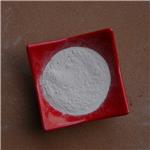- 2-Ketoglutaric acid
-

- $10.00/ KG
-
2025-04-15
- CAS:328-50-7
- Min. Order: 1KG
- Purity: 99%
- Supply Ability: 500000kg
- 2-Ketoglutaric acid
-

- $0.00 / 1kg
-
2025-04-15
- CAS:328-50-7
- Min. Order: 1kg
- Purity: 97%
- Supply Ability: 1000
|
| | 2-Ketoglutaric acid Basic information |
| | 2-Ketoglutaric acid Chemical Properties |
| Melting point | 113-115 °C | | Boiling point | 185.67°C (rough estimate) | | density | 1.2821 (rough estimate) | | bulk density | 800kg/m3 | | vapor pressure | 0.01Pa at 25℃ | | FEMA | 3891 | 2-OXOPENTANEDIOIC ACID | | refractive index | 1.3920 (estimate) | | storage temp. | 2-8°C | | solubility | H2O: soluble0.1g/mL, clear, colorless | | form | Crystalline Powder | | pka | 2.47(at 25℃) | | color | White to slightly yellow | | Odor | Odorless | | PH | 3.09(1 mM solution);2.36(10 mM solution);1.77(100 mM solution) | | Water Solubility | Soluble in water, methanol and dimethyl sulfoxide. | | Merck | 14,5303 | | JECFA Number | 634 | | BRN | 1705689 | | InChIKey | KPGXRSRHYNQIFN-UHFFFAOYSA-N | | LogP | -2.08 at 25℃ | | CAS DataBase Reference | 328-50-7(CAS DataBase Reference) | | NIST Chemistry Reference | 2-Oxopentanedioic acid(328-50-7) | | EPA Substance Registry System | Pentanedioic acid, 2-oxo- (328-50-7) |
| | 2-Ketoglutaric acid Usage And Synthesis |
| Description | 2-Ketoglutaric acid also known as α-Ketoglutaric acid (AKG) is a chemical found in the body. It is a ketone derivative of the organic compound glutaric acid. It is important for the proper metabolism of all essential amino acids and the transfer of cellular energy in the citric acid or Krebs cycle. In combination with L-glutamate, AKG can reduce levels of ammonia formed in the brain, muscles, and kidneys, as well as help balance the body’s nitrogen chemistry and prevent nitrogen excess in body tissues and fluids.
α-Ketoglutaric acid is used for kidney disease; intestinal and stomach disorders, including bacterial infections; liver problems; cataracts; and recurring yeast infections. It is also used for improving the way kidney patients receiving hemodialysis treatments process protein. | | Chemical Properties | 2-Ketoglutaric acid is a white to yellowish crystalline powder. It is easily soluble in water, alcohol, and extremely insoluble in ether. It becomes light gray-yellow when stored for a long time, and is easy to deliquescence. | | Uses | 2-Ketoglutaric acid has a wide range of applications in the animal feed, food, pharmaceutical and fine chemistry industries. It is used as an intermediate in the kreb's cycle catalyzed by glutamate dehydrogenase enzyme on glutamate. It is also used in dietary supplements to improve protein synthesis. | | Preparation | Synthesis of α-ketoglutaric acid: 225 g of triethyl nitrilotricarboxylate and 600 ml of concentrated hydrochloric acid were mixed and left to pass through. It was concentrated by distillation to 140°C, and the residue was crystallized by cooling to obtain 110-112 g of α-ketoglutaric acid with a yield of 92-93%. | | Definition | ChEBI: 2-oxoglutaric acid is an oxo dicarboxylic acid that consists of glutaric acid bearing an oxo substituent at position 2. It is an intermediate metabolite in Krebs cycle. It has a role as a fundamental metabolite. It derives from a glutaric acid. It is a conjugate acid of a 2-oxoglutarate(1-). | | Application | 2-Ketoglutaric acid is a derivative of glutaric acid. It plays an important role in the metabolism of microbial cells and It acts as precursor for the synthesis of amino acids and nucleotides. α-ketoglutaric acid along with L-arginine can undergo reduction with sodium cyanoborohydride to form the diastereomers, nopaline and isonopaline. α-ketoglutaric acid can be prepared in 1:1 and 2:1 L-arginine alpha-ketoglutarate for sports nutrition. mainly as an ingredient in sports nutrition drinks. | | General Description | 2-Ketoglutaric acid is a 2-oxocarboxylic acid (2-OCA), one of the important intermediates in the Krebs cycle, after isocitrate and before succinyl CoA. It is an important nitrogen transporter and is transaminate along with glutamine to form glutamate. It can be used to differentiate microorganisms based on metabolic properties. It also possesses metabolic properties, decreasing the level of hydrogen peroxide in cell culture. | | Flammability and Explosibility | Not classified | | Biotechnological Applications | a-Ketoglutaric acid is an intermediate of the tricarboxylic acid cycle and the main compound of amino acid and protein metabolism. This organic acid could be used as building-block chemical for the chemical synthesis of heterocycles, dietary supplement, component of infusion solutions, and wound healing compounds (Otto et al. 2013). | | Purification Methods | Crystallise the keto-acid repeatedly from Me2CO/*benzene, EtOAc or ethyl propionate. Dry it in vacuo.[Beilstein 3 IV 1813.] |
| | 2-Ketoglutaric acid Preparation Products And Raw materials |
| Raw materials | Succinic acid-->Pentanedioic acid, 2-oxo-, 1-ethyl ester-->L-Glutamic acid, N-[(2S)-2-amino-2-carboxyethyl]--->(1R,2S)-1-hydroxypropane-1,2,3-tricarboxylic acid-->Glufosinate-P-->4-Hydroxyphenylpyruvic acid-->3-Phenylpyruvic acid-->SUCCINALDEHYDIC ACID-->2,5-Furandicarboxylic acid-->pyridoxal-->D(-)-Glutamic acid-->DL-Glutamic acid-->L-Tyrosine-->2-AMINOPHENOL HYDROCHLORIDE-->triethyl nitrilotricarboxylate | | Preparation Products | L-GLUTAMIC-2,3,3,4,4-D5 ACID-->ALPHA-KETOGLUTARIC ACID MONOSODIUM SALT-->4-Carbethoxybutyrolactone,γ-Carboethoxy-γ-butyrolactone-->6-Chloro-pyridazine-3-carboxylic acid ethyl ester |
|